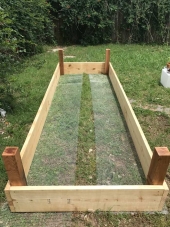
 17
17




 6
6




I make a Maple Syrup instructional movie! Check it out HERE
SKIP books, get 'em while they're hot!!! Skills to Inherit Property
See me in a movie building a massive wood staircase:Low Tech Lab Movie
 3
3




 3
3




A human being should be able to change a diaper, plan an invasion, butcher a hog, conn a ship, design a building, write a sonnet, balance accounts, build a wall, set a bone, comfort the dying, take orders, give orders, cooperate, act alone, solve equations, analyze a new problem, pitch manure, program a computer, cook a tasty meal, fight efficiently, die gallantly. Specialization is for insects.
-Robert A. Heinlein
 1
1




 3
3




Chris Kott wrote:
Another approach that has always made sense to me is that of guys who walk their dogs along the property line and join them in marking territory in situations where deterring predators or pest animals from the garden is necessary.
 1
1




A human being should be able to change a diaper, plan an invasion, butcher a hog, conn a ship, design a building, write a sonnet, balance accounts, build a wall, set a bone, comfort the dying, take orders, give orders, cooperate, act alone, solve equations, analyze a new problem, pitch manure, program a computer, cook a tasty meal, fight efficiently, die gallantly. Specialization is for insects.
-Robert A. Heinlein
 5
5




Argue for your limitations and they are yours forever.
 2
2




Chris Kott wrote:
Also, if there are motion-sensitive elements that only activate when they breach the perimeter, that could be enough to make them doubt their surveillance.
-CK
 1
1








 1
1




Tom Kozak wrote:I only know the word teotwawki as an acronym for The End Of The World As We Know It. What does it mean in this context?
A build too cool to miss:Mike's GreenhouseA great example:Joseph's Garden
All the soil info you'll ever need:
Redhawk's excellent soil-building series





 3
3




 1
1




Lucrecia Anderson wrote:Great tips. I like the bamboo idea, wonder if there are non-invasive varieties? I know bamboo is a big big problem in some areas (hard to remove and starts lifting the foundations around homes etc...) but if there is plenty of space it probably isn't.
Bless your Family,
Mike




Lucrecia Anderson wrote:
Chris Kott wrote:
Also, if there are motion-sensitive elements that only activate when they breach the perimeter, that could be enough to make them doubt their surveillance.
-CK
One easy/cheap motion sensor that I keep on hand (for teotwawki not for deer, though it would work in either case) is a fishing line tripwire alarm.
Run the fishing line along the perimeter and attach it either to mousetraps or the cheap dollar store magnetic window alarms. When the line is tripped the window alarm goes off (and you have to turn it off) or it trips the mousetrap which fires off a strip of ring caps (for kids pop guns). Either way it makes a big noise and no power is required plus the supplies are less than $10.
I just fenced my garden area in and that keeps them out, it is small and isn't tempting enough to bother entering the fenceline.
Bless your Family,
Mike
 1
1




Mike Barkley wrote: I have an acre or two of zone 2 & 3 area that has many large divots. This is how I'm leveling the divots as well as starting new gardens there. One day at a time, one bucket at a time.
Bless your Family,
Mike
 1
1




Lucrecia Anderson wrote:
so they aren't the slightest bit worried.Chris Kott wrote:
Another approach that has always made sense to me is that of guys who walk their dogs along the property line and join them in marking territory in situations where deterring predators or pest animals from the garden is necessary.
We may not see them very often but there is no doubt they watch/study us, know what our habits are and carefully assess the threat level.
Bless your Family,
Mike
 2
2




 3
3




 6
6








Bless your Family,
Mike
 2
2




 1
1




Lana Weldon wrote:I read once something about how a region in Thailand once had a huge problem with grasshoppers on their fields (I think it was corn). They tried all sort of things to get rid of the plague, nothing really worked. In the end, the government actually proposed that the locals start harvesting and eating the bugs. But this was not traditionally a bug eating region, so it did take some effort, but in the end it worked out: providing protein and getting rid of excess bugs.

Bless your Family,
Mike
 2
2





|
Hang a left on main. Then read this tiny ad:
The new gardening playing cards kickstarter is now live!
https://www.kickstarter.com/projects/paulwheaton/garden-cards
|





